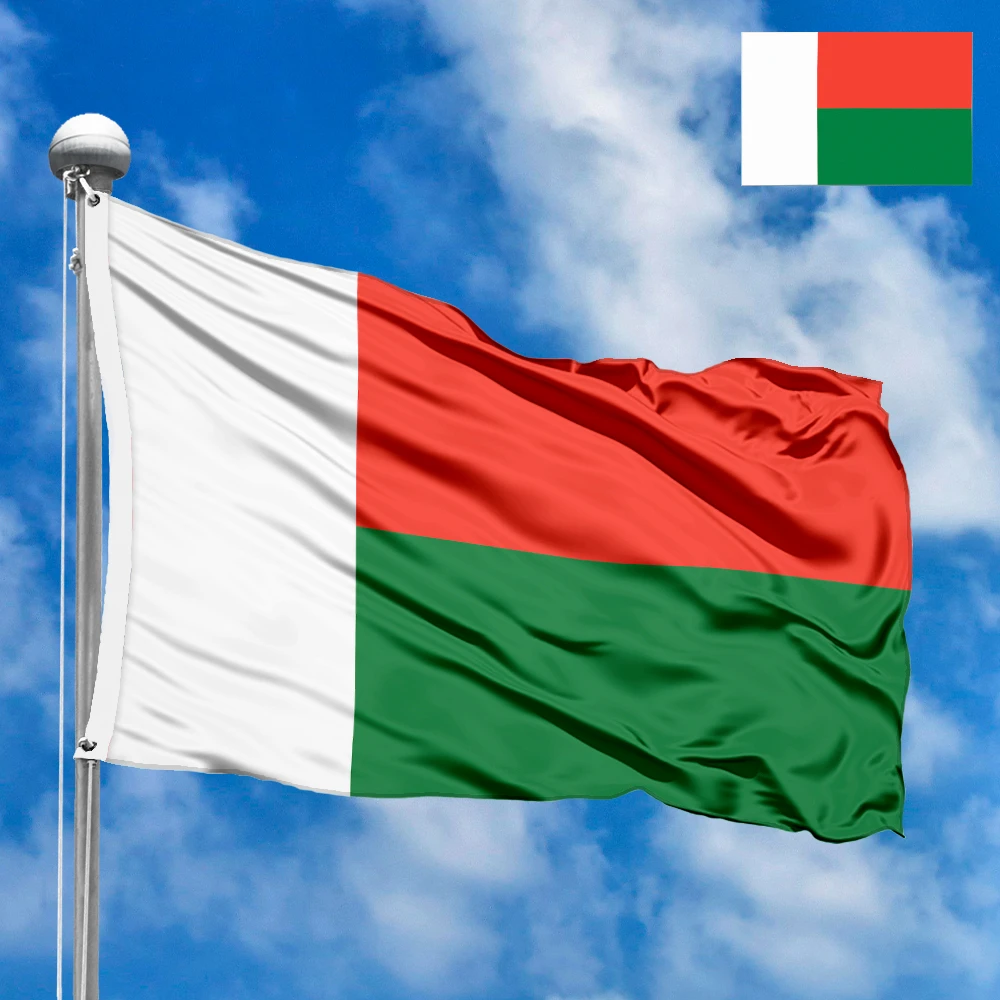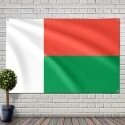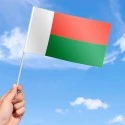The national flag of the Republic of Madagascar is a distinct and resonant emblem, symbolizing the nation's unique identity, its rich cultural heritage, and its historical path to independence. Adopted on October 14, 1958, two years before the island gained full independence from France, the flag's design was strategically chosen to reflect Madagascar's history, its traditional values, and its future aspirations. It stands as a vibrant testament to the island nation's sovereignty and its profound connection to both African and Southeast Asian roots.
Design and Symbolism: A Trio of History, Purity, and Hope
The flag of Madagascar features a unique composition, deviating from the more common tricolors found across Africa. It consists of a vertical white band on the hoist side, and two horizontal bands, red above green, on the fly side. Each color is deeply imbued with historical and cultural significance:
-
White (Vertical Band - Hoist Side): The broad white vertical band, positioned closest to the flagpole, holds profound symbolic weight. It represents purity, peace, and the traditional values of the Malagasy people. Historically, white was the color of the Merina kingdom, which was the dominant pre-colonial kingdom on the island, and the color of the voahangy (a traditional white garment) worn during significant ceremonies. It signifies the integrity and sincerity of the Malagasy nation and its commitment to harmonious living.
-
Red (Top Horizontal Band - Fly Side): The upper horizontal red band symbolizes sovereignty, independence, and the blood of the Malagasy martyrs who fought against colonial rule and for the nation's freedom. Red is historically associated with the Hova caste (a class within the Merina kingdom), reflecting the historical lineage and the sacrifices made in defense of the Malagasy identity. It also represents the strength and determination of the Malagasy people to maintain their hard-won autonomy.
-
Green (Bottom Horizontal Band - Fly Side): The lower horizontal green band represents hope, the fertile land of Madagascar, and the agricultural prosperity that is vital to the nation's economy. Green is traditionally associated with the coastline communities and the agricultural workers, signifying the island's diverse natural resources, its lush landscapes, and the aspirations for future growth and development. It embodies the nation's reliance on its natural environment and its commitment to a sustainable future.
The unique combination and arrangement of these colors make the Malagasy flag instantly recognizable and distinct from other national flags, reflecting the island's unique position at the crossroads of African and Asian cultures.
Dimensions and Proportions:
The official proportions of the Flag of Madagascar are a width-to-length ratio of 2:3. This is a commonly used standard for national flags, providing a balanced and aesthetically pleasing appearance. The vertical white stripe occupies one-third of the flag's length, while the two horizontal stripes (red and green) each occupy one-half of the remaining two-thirds of the flag's length. This precise division ensures visual harmony and emphasizes the distinctiveness of the white vertical band.
History and Evolution: From Merina Kingdom to Independent Republic
The history of the Malagasy flag is intricately woven with the island's pre-colonial kingdoms, French colonial rule, and its eventual path to self-determination.
-
Merina Kingdom (Pre-Colonial Era): Before French colonization, the Kingdom of Imerina (Merina Kingdom) was the dominant power on the island. Its flag prominently featured red and white colors, reflecting the historical significance of these hues to the central highlands people. This historical precedent heavily influenced the choice of colors for the modern national flag.
-
French Colonial Rule (Late 19th Century - 1958): From the late 19th century until 1958, Madagascar was a French colony. During this period, the French Tricolour (blue, white, red) was the official flag. However, local resistance movements and growing nationalist sentiments kept the desire for a distinct Malagasy identity alive.
-
Path to Independence and Adoption of the Flag (1958): As Madagascar moved towards gaining autonomy within the French Community, a new flag was needed. The current design was officially adopted on October 14, 1958, as the flag of the autonomous Malagasy Republic. The design was chosen to resonate with the island's history and its diverse ethnic groups. The red and white recalled the colors of the Merina Kingdom, while the green was added to represent the coastal communities and the peasants who historically opposed the Merina dominance but were united in the goal of independence. This inclusive symbolism aimed to foster national unity.
-
Full Independence (June 26, 1960): When Madagascar gained full independence from France on June 26, 1960, the flag adopted in 1958 was retained as the national flag of the Republic of Madagascar. It has remained unchanged since then, serving as a consistent symbol of national unity, sovereignty, and the diverse heritage of its people.
Regional Context and Island Identity:
Madagascar is the world's fourth-largest island nation, located off the southeast coast of Africa in the Indian Ocean. Its flag stands out in the regional vexillological landscape. While many African flags adopt Pan-African colors (green, yellow, red), Madagascar's flag, with its prominent white vertical stripe and distinct arrangement, reflects its unique ethnolinguistic heritage, which combines elements of Southeast Asian (specifically Borneo) and East African cultures. The island's history of successive migrations has created a distinct cultural tapestry that is subtly reflected in its national symbol.
While geographically part of Africa, Madagascar's flag visually distinguishes it from the mainland African nations, underscoring its unique island identity and its cultural connections that span beyond the African continent. This distinctiveness reinforces Madagascar's position as a crossroads of cultures and its singular historical trajectory.
Interesting Facts:
-
Pre-Independence Adoption: The flag was adopted in 1958, two years before Madagascar gained full independence from France, signaling the nation's readiness for self-rule.
-
Merina Kingdom Influence: The red and white colors are derived from the historical flag of the Kingdom of Imerina, the dominant pre-colonial kingdom.
-
Symbol of Unity: The inclusion of green was a deliberate act to represent the coastal populations and peasants, aiming to unite different historical factions under a common national symbol.
-
Unique Design: Its design with a vertical band and two horizontal bands is unusual among national flags, especially in Africa, highlighting Madagascar's unique identity.
-
Fourth Largest Island: Madagascar is the fourth-largest island in the world, and its flag represents this significant landmass and its diverse ecosystems.
-
"Red Island": Madagascar is often referred to as the "Red Island" due to its distinctive red lateritic soil, a color prominently featured on the flag.
-
Symbol of Resilience: The flag embodies the Malagasy people's resilience and their successful struggle for self-determination against colonial powers.
-
Cultural Crossroads: The flag implicitly represents Madagascar's unique position as a cultural crossroads between African and Southeast Asian influences.
-
Unchanged Since 1958: Despite political changes, the flag's design has remained constant since its adoption, reflecting its enduring acceptance and symbolism.
Significance for the Inhabitants: A Banner of Heritage, Unity, and Aspiration
For the people of Madagascar, their national flag is a source of profound pride and a powerful symbol that encapsulates their rich heritage, their hard-won unity, and their enduring aspirations for the future. It serves as a visual narrative of their distinct identity as an island nation at the confluence of diverse cultures.
The white stripe represents the core values of purity, peace, and integrity that are central to Malagasy society. It reminds citizens of their shared traditions, their spiritual beliefs, and the importance of harmonious coexistence. This color evokes a sense of moral foundation and a commitment to justice.
The red stripe speaks to the sacrifices made for their freedom. It is a powerful reminder of the struggles against colonial rule and the blood shed by their ancestors to establish a sovereign nation. This aspect of the flag instills a deep sense of patriotism, courage, and a collective responsibility to protect their independence and national dignity. It is a symbol of their unyielding spirit.
The green stripe represents the land that sustains them – the fertile fields, the lush forests, and the agricultural bounty that forms the bedrock of their livelihoods. It symbolizes hope for a prosperous future, rooted in sustainable development and the wise utilization of their natural resources. This color fosters a connection to their environment and encourages a commitment to building a thriving economy for all Malagasy people.
Together, these colors weave a tapestry of national identity that transcends regional and historical divisions. The flag unites the diverse ethnic groups of Madagascar under a common banner, fostering a sense of shared destiny and collective purpose. Whether displayed at national celebrations, in schools, or during daily life, the flag serves as a beacon of unity, reminding Malagasy citizens of their unique heritage, their resilience in the face of adversity, and their collective journey towards a peaceful and prosperous future. It is a cherished emblem that evokes a deep emotional connection to their homeland and their people.
In the demonstration images, full-size flags are shown with proportions of 2:3, and hand-held flags with proportions of 1:2.






 Waving flag
Waving flag
 Sizes:
Sizes:
 Round flag
Round flag
 Sizes:
Sizes:
 Rectangular flag 2:3
Rectangular flag 2:3
 Sizes:
Sizes: